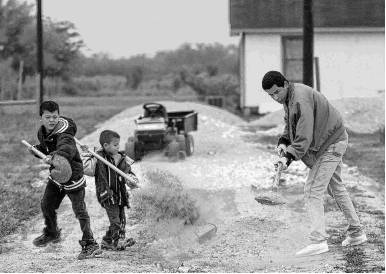Revisit the status of colonias, ‘new colonias’
By Coda Rayo-Garza FOR THE EXPRESS-NEWS
In 2017, Gov. Greg Abbott divested nearly $860,000 that had been used to fund the Colonias Initiative Program, which sent a resounding message to the people of Texas that our state can underserve our most vulnerable residents.
As we prepare to enter another legislative session, it is important for those in the Texas Capitol to know that in this moment, when the federal government is sending the same message through policies such as family separation and the new public charge rule, we will not stand for this kind of inequity in Texas.
Therefore, we must demand that the Legislature provide an updated report on the status of colonias along the Texas-Mexico border and expand the definition of colonias to include “new colonias.”
Colonia funding is not new to Texas and other border states. In 1991, the Cranston-Gonzalez National Affordable Housing Act required Arizona, California, New Mexico and Texas to set aside up to 10 percent of their annual Community Block Development Grants allocations for colonia support.
As HUD secretary, Julián Castro advocated for an additional 5 percent to be reserved for colonia funding.
A 2014 a report prepared by the Texas Office of the Secretary of State noted that while significant challenges and barriers remain, colonias continued to make progress in updating their infrastructure, and the state must therefore continue funding programs providing them assistance.
The report also referenced issues identified in 2010 that remained unresolved. Of those, the first was the question of what defines a colonia: At what point does a designated colonia cease to be considered a colonia?
Other unresolved questions include: Does a colonia designation cease once colonia residents access basic services such as potable water, effective and safe disposal of wastewater, and access to paved roads?
The answer to the second question is no — and a part of that answer lies in data.
Overall, the 2014 report had a major flaw: It relied too heavily on mere infrastructure systems to attempt to declassify colonias. Essentially, the report categorized colonias into three colors.
Red colonias lacked access to potable water, adequate wastewater disposal, or were unplatted.
Yellow colonias had access to potable water via a functional well or connection to a public water system, functional septic tank or connection to a public wastewater collection system, but lacked adequate road paving, drainage or solid waste disposal.
Green colonias had access to potable water, adequate wastewater disposal, adequate paved roads, drainage and solid waste disposal.
However, these color designations failed to provide an accurate understanding of colonias; the report should have additionally analyzed educational attainment, employment status, household income, poverty status and government assistance.
In light of the report’s flaw, the Legislature must provide an updated report and include “new colonias,” which are generally defined as formerly constructed subdivisions that comply with the model subdivision rules.
Overall, new colonias contain roads and water/ wastewater infrastructure, but still have unsafe, dilapidated housing that may not be connected to existing services.
New colonias require immediate funding. I know this fact well, given the new colonia I grew up in, which was nestled less than a mile from the Rio Grande behind a series of warehouses. Many of those homes — which were only updated gradually, as the homeowners’ funding permitted — would surely fail to meet current building code standards.
The phenomenon of “new colonias” has not been explored as a category in and of itself; therefore, the state of Texas should conduct a more comprehensive analysis of the state of colonias and new colonias for funding via state and federal sources.
Colonias in general are still underserved, and this is demonstrated by data that support the need for the Legislature to expand the definition of colonias in order to better provide holistic development support.
According to the recently published American Community Survey data, the poverty concentration along border metropolitan cities is the highest in Texas, and the gap between border metro areas without health insurance and other non-border areas is huge.
Moreover, high school graduation rates in some border towns are much lower than the state average of 83 percent. Furthermore, sustainability and environmental factors, such as flooding and flood plains, need to be accounted for in examining the state of colonias in Texas.
Given these glaring disparities, it’s time we reconsider colonia funding. This, however, entails that we rethink one of the questions asked in the 2014 report: At what point does a designated colonia cease to be considered a colonia?
Asking this question for the sake of removing colonias from a list is unjust. As someone who grew up in a new colonia, I know the consequences of a deficit in services that has persisted for years and that it will take more than just laying infrastructure in the ground.
In other words, we need to acknowledge the historical legacy and impacts that colonias have on the people living there. The stress and trauma resulting from growing up in a colonia affect individuals later in life. This is why colonia funding must be based on a much more expansive definition.
We need to understand that colonias will remain colonias as long as infrastructure lags and consequential inequalities in services persist.
Strong and resilient communities are good for our democracy. Trust in our government to provide for its people the basic infrastructure and the opportunities that the rest of the country enjoys. This is critical for colonia communities that are still underserved.
The Texas Legislature needs to request an updated report on the status of colonias along the Texas-Mexico border and expand the definition of colonias so the support heavily needed in these areas is not constricted.
Coda Rayo-Garza is a political partner with Truman National Security Project. The views expressed are her own.


